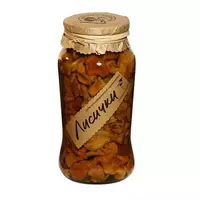Pickled chanterelles

Common or real chanterelles belong to the most famous and fervently beloved species of mushrooms by the inhabitants of our latitudes. Chanterelles are separated in accordance with the scientific classification into a separate family of the same name. The chanterelles got their original name due to the similarity of the colors of the fruit body of mushrooms with the color of the fox coat.
Most often, chanterelles grow in forests located in temperate areas. Usually, chanterelles grow in close proximity to trees such as pine, oak, spruce or beech. The main feature of chanterelles, of course, in addition to the bright orange juicy color, can be considered the group arrangement of the edible fruit body of mushrooms.
As a rule, chanterelles appear after summer showers with thunderstorms, and numerous groups of mushrooms can be noticed. The first harvest of chanterelles can be harvested at the beginning of June. The second mushroom season for chanterelles begins between August and October. There are two main types of edible chanterelles - velvety and faceted chanterelle.
In addition, false or inedible chanterelles are found, as well as omphalot olive, similar in appearance to a mushroom, poisonous and dangerous to human life and health. Chanterelles are considered a fairly valuable mushroom that can be eaten in any form. Mushrooms such as chanterelles are quite well stored and withstand transportation.
Chanterelles are recognized as kosher food as this fungus is quite rarely susceptible to raids by pests or worms. In cheeses, the taste of chanterelles is characterized by acid, which disappears when boiling mushrooms. Professional culinary and amateur mushroom pickers claim that few mushroom products can match the taste and consumer characteristics of pickled chanterelles.
Such a product as pickled chanterelles boasts not only outstanding taste, but also useful abilities. The chemical composition of pickled chanterelles, as well as fresh mushrooms, contains a large amount of chitinmannose, trametonolinic acid, as well as ergosterol. These compounds help maintain the performance of some human organs, such as the liver or gastrointestinal tract.
In addition, pickled chanterelles contain eight amino acids indispensable for the human body, as well as vitamins of group A, B, C and PP. Properly marinated chanterelles can become not only very tasty, but also an absolutely useful treat for people of all ages. Since chanterelles are virtually non-worm and clean well, mushrooms can be considered a suitable plant product for home preservation.
Of course, you can buy the coveted jar of pickled chanterelles in most domestic grocery stores. However, home blanks always differ markedly in their quality and taste from the mass-produced version. Pickled chanterelles are served to the table as a snack of their own, combined with onions of onions. In addition, pickled chanterelles are included in some mushroom salads.
pickled chanterelles 18 kCal
Energy value of pickled chanterelles (Ratio of proteins, fats, carbohydrates - ju):
Proteins: 1 g (~ 4 kCal)
Fats: 0 g (~ 0 kCal)
Carbohydrates: 2g (~ 8kCal)
Energy ratio (bj | y): 22% | 0% | 44%
 Español
Español Français
Français Português
Português Русский
Русский 简体中文
简体中文 繁體中文
繁體中文 日本語
日本語 한국어
한국어 العربية
العربية Türkçe
Türkçe Қазақ
Қазақ Deutsch
Deutsch Italiano
Italiano Українська
Українська
